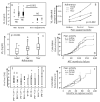Implementation and Operational Research: Correlates of Adherence and Treatment Failure Among Kenyan Patients on Long-term Highly Active Antiretroviral Therapy
- PMID: 26009836
- PMCID: PMC4445604
- DOI: 10.1097/QAI.0000000000000580
Implementation and Operational Research: Correlates of Adherence and Treatment Failure Among Kenyan Patients on Long-term Highly Active Antiretroviral Therapy
Abstract
Background: Universal access to highly active antiretroviral therapy (HAART) is still elusive in most developing nations. We asked whether peer support influenced adherence and treatment outcome and if a single viral load (VL) could define treatment failure in a resource-limited setting.
Methods: A multicenter longitudinal and cross-sectional survey of VL, CD4 T cells, and adherence in 546 patients receiving HAART for up to 228 months. VL and CD4 counts were determined using m2000 Abbott RealTime HIV-1 assay and FACS counters, respectively. Adherence was assessed based on pill count and on self-report.
Results: Of the patients, 55.8%, 22.2%, and 22% had good, fair, and poor adherence, respectively. Adherence, peer support, and regimen, but not HIV disclosure, age, or gender, independently correlated with VL and durability of treatment in a multivariate analysis (P < 0.001). Treatment failure was 35.9% using sequential VL but ranged between 27% and 35% using alternate single VL cross-sectional definitions. More patients failed stavudine (41.2%) than zidovudine (37.4%) or tenofovir (28.8%, P = 0.043) treatment arms. Peer support correlated positively with adherence (χ(2), P < 0.001), with nonadherence being highest in the stavudine arm. VL before the time of regimen switch was comparable between patients switching and not switching treatment. Moreover, 36% of those switching still failed the second-line regimen.
Conclusion: Weak adherence support and inaccessible VL testing threaten to compromise the success of HAART scale-up in Kenya. To hasten antiretroviral therapy monitoring and decision making, we suggest strengthening patient-focused adherence programs, optimizing and aligning regimen to WHO standards, and a single point-of-care VL testing when multiple tests are unavailable.
Figures

References
-
- Selik RM, Lindegren ML. Changes in deaths reported with human immunodeficiency virus infection among United States children less than thirteen years old, 1987 through 1999. Pediatr Infect Dis J. 2003;22(7):635–641. - PubMed
-
- Monpoux F, Tricoire J, Lalande M, Reliquet V, Bebin B, Thuret I. Treatment interruption for virological failure or as sparing regimen in children with chronic HIV-1 infection. Aids. 2004;18(18):2401–2409. - PubMed
-
- Gilks CF, Crowley S, Ekpini R, et al. The WHO public-health approach to antiretroviral treatment against HIV in resource-limited settings. Lancet. 2006;368(9534):505–510. - PubMed
-
- Batz HG, Guillerm M, Gonsalves G. Scaling up antiretroviral treatment in resource-poor settings. Lancet. 2006;368(9534):445. - PubMed
Publication types
MeSH terms
Substances
Grants and funding
LinkOut - more resources
Full Text Sources
Medical
Research Materials

